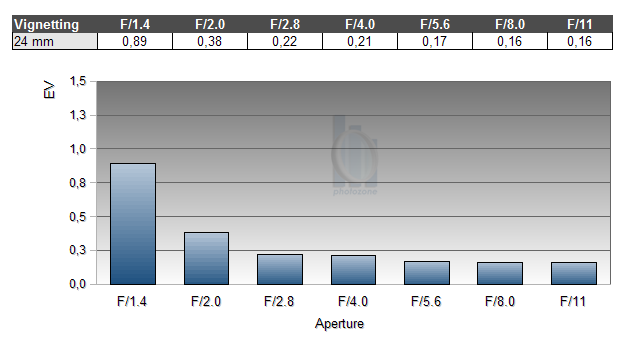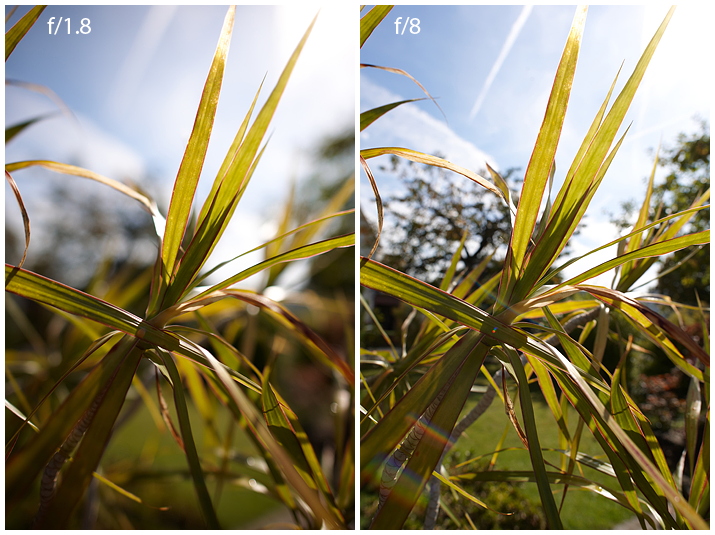|
Page 2 of 2

Distortion
The lens shows a small amount of barrel distortion on DX cameras.

The chart above has a real-world size of about 120x80cm.
Vignetting
Being a FX lens, the Nikkor profits from the sweet spot advantage on DX cameras. So, even though it's a very fast lens, it shows only moderate vignetting wide open, which is reduced to an irrelevant level at f/2 already.

MTF (resolution)
The lens delivers excellent resolution in the image center straight from the maximum aperture, down to f/8. From f/11 onwards, diffraction significantly reduces the resolution figures.
The borders show good resolution wide open. Stopped down to f/2.8 they reach very good levels. The extreme corners are rather soft wide open. The lens needs to be stopped down to f/5.6 to reach very good (albeit just) resolution here.
The lens showed some focus shift when stopping down (residual spherical aberration).
Please note that the MTF results are not directly comparable across the different systems!
Below is a simplified summary of the formal findings. The chart shows line widths per picture height (LW/PH) which can be taken as a measure for sharpness.
If you want to know more about the MTF50 figures you may check out the corresponding Imatest Explanations

Chromatic Aberrations (CAs)
Chromatic aberrations (color shadows at harsh contrast transitions) are somewhat pronounced, reaching almost 1.6 pixels at the image border wide open. Stopping down reduces the amount a little, but even at f/11 more than 1 pixel of CAs remains.
However, CAs can easily be corrected in software or by the camera itself (most modern Nikon DSLRs remove CAs themselves if you shoot JPGs).

Bokeh
One of the primary usage scenarios for a large aperture lens is to seperate the main subject from the background. In such an image the quality of the bokeh (out-of-focus blur) is of major significance.
Bad news first - the bokeh in front of the focal plane can be somewhat nervous. However, for a wide angle lens, this is hardly a field-relevant issue. Behind the focal plane, the lens produces very smooth and pleasant blur, including the transistion zones.
Thanks to 9 rounded aperture blades, background highlights retain their circular shape throughout the whole aperture range. Highlights are evenly filled, there is almost no outlining, but some traces of bokeh fringing (which is typical for this lens class, see next section). For a wide angle lens, this is a very impressive performance.

Bokeh Fringing
Bokeh fringing is a common issue with relatively fast glass. It's visible as halos of different colors in out-of-focus areas - magenta (red + blue) in front of the focus point
and green beyond.
Typical for most fast primes, especially ultra fast ones, the AF-S 24 shows some amount of bokeh fringing at large aperture settings, which can of course be reduced by stopping down.
In addition, these shots also show the focus shift when stopping down, which was mentioned in the MTF section.
Flare/Glare
It does not come as a surprise that a lens as complex as the AF-S 24 produces some amount of flare in backlight conditions. As you can see in the f/8 sample below (shot with an FX camera), there's a single spot and a bunch of rainbow coloured shades opposite to the source of the light. However, thanks to Nano Coating the total amount is rather low and the contrast remains on a very high level. This (high contrast) is also true for large apertures, where the flare spot is larger but also more transparent and only single coloured and the rainbow flares are reduced to a slight haze.
These two images are also available in full resolution in the sample images section of the FX review of this lens.

Sample Images
You can find some sample images taken with the Nikon D3x in our Nikon FX review of the lens.
VerdictThe Nikkor AF-S 24 f/1.4 is a nice ultra-fast wide-angle lens. At large apertures it produces very sharp images in the image center with somewhat soft corners wide open. The lens needs to be stopped down to achieve very good sharpness across the frame. CAs are a bit pronounced wide open.
Bokeh fringing is present at larger apertures, but this is typical for such a fast prime. Since the lens is designed for a larger image circle, vignetting is only an issue at the larges aperture setting, but not when stopped down. The bokeh is very smooth and actually pretty much outstanding for such a wide angle lens. Flare is well under control.
As you'd expect from a professional-grade lens, the build quality is on a very high level, including sealing against dust and moisture.
One feature not mentioned yet is the lens' ability to focus rather close (0.25m) which, combined with the wide angle of view and large aperture, can lead to very interesting perspectives and unique results. On DX, however, some of its appeal is lost due to the crop factor. On the other hand, those who shoot with both FX and DX camera get two lenses in one, a really wide and fast 24mm on FX, and a 35mm equivalent lens on DX.
So in summary it's a very fine piece of glass that's fun to use. A somewhat specialized and certainly pricey tool though.
|